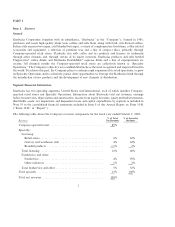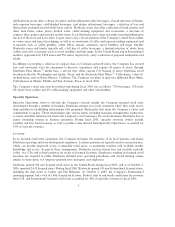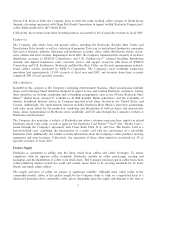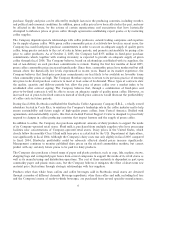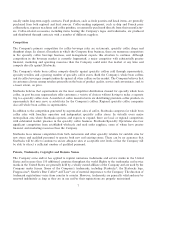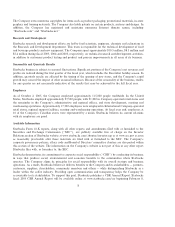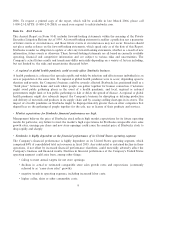Starbucks 2005 Annual Report Download - page 13
Download and view the complete annual report
Please find page 13 of the 2005 Starbucks annual report below. You can navigate through the pages in the report by either clicking on the pages listed below, or by using the keyword search tool below to find specific information within the annual report.‚ unfavorable general economic conditions in the markets in which Starbucks operates, including, but
not limited to, changes in interest rates, unemployment rates, disposable income and other events or
factors that adversely affect consumer spending;
‚ unanticipated changes in executive management;
‚ failing to manage the impact on Starbucks business of factors such as labor discord, war, terrorism,
political instability in certain markets and natural disasters; and
‚ interruptions in service by common carriers that ship goods within the Company's distribution
channels.
‚The Company's success depends substantially on the value of the Starbucks brand.
Starbucks believes it has built an excellent reputation globally for the quality of its products, for delivery of a
consistently positive consumer experience and for its corporate social responsibility programs. The Starbucks
brand has been highly rated in several global brand value studies. Management believes it must preserve and
grow the value of the Starbucks brand to be successful in the future, particularly outside of North America,
where the Starbucks brand is less well known. Brand value is based in part on consumer perceptions as to a
variety of subjective qualities, and can be damaged badly even by isolated business incidents that degrade
consumer trust, particularly if the incidents receive considerable publicity or result in litigation. Consumer
demand for the Company's products and its brand equity could diminish significantly if Starbucks fails to
preserve the quality of its products, is perceived to act in an unethical or socially irresponsible manner or fails
to deliver a consistently positive consumer experience in each of its markets.
‚Effectively managing the Company's rapid growth is challenging.
The Company's long-term goal is to open approximately 15,000 Starbucks stores in the United States and at
least 15,000 stores in International markets. Starbucks expects annual total net revenue growth of approxi-
mately 20% and annual earnings per share growth of approximately 20-25% for the next three to five year
period (excluding fiscal 2006, when Starbucks begins recording the effect of stock compensation as an expense
using the modified prospective transition method). Effectively managing growth on this scale is challenging,
particularly as Starbucks expands into new markets internationally, and it becomes increasingly difficult to
ensure a consistent supply of high quality raw materials, to hire sufficient numbers of key employees to meet
the Company's growth targets, to maintain an effective system of internal controls for a globally dispersed
enterprise and to train employees worldwide to deliver a consistently high quality product and customer
experience. Achieving the Company's growth targets is also dependent on its ability to open more new stores
in the current year as well as future years than it opened in prior years.
‚The loss of key personnel or any difficulty recruiting and retaining qualified personnel could jeopardize the
Company's ability to meet its growth targets.
The success of the Company's efforts to grow its business depends on the contributions and abilities of key
executive and operating officers and other personnel. Starbucks must continue to recruit, retain and motivate
management and operating personnel sufficient to maintain its current business and support its projected
growth. A shortage of these key employees might jeopardize the Company's ability to meet its growth targets.
11


